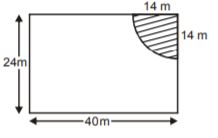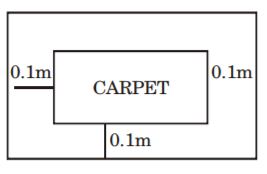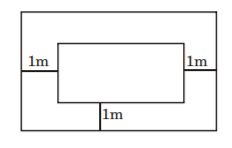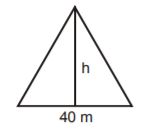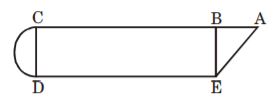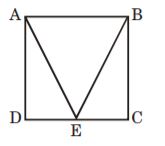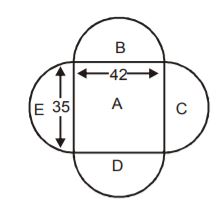 Introduction
Introduction
Mensuration is a topic in Geometry which is a branch of mathematics. Mensuration deals with length, area and volume of different kinds of shape- both 2D and 3D. The article Mensuration Practice Quiz provides information about Mensuration, a important topic of Mathematics Consists of different types Mensuration questions with solutions useful for candidates preparing for different competitive examinations like RRB .RRB ALP/Technical Exams/Junior Engineer Recruitment Exams, SSC CGL,SSC CHSL, IBPS, SBI PO, SBI Clerks, CAT and etc.
 Quiz
Quiz
1. The length of the longest rod that can be placed in a room which is 12 m long, 9 m broad and 8 m high is
- A. 27 m
B. 19 m
C. 17 m
D. 13 m
- A. 32 cubic metres
B. 36 cubic metres
C. 40 cubic metres
D. 44 cubic metres
- A. 8000 [latex]{cm}^{3}[/latex]
B. 1000 [latex]{cm}^{3}[/latex]
C. 125 [latex]{cm}^{3}[/latex]
D. 400 [latex]{cm}^{3}[/latex]
- A. 120 [latex]\pi {cm}^{2}[/latex]
B. 60 [latex]\pi {cm}^{2}[/latex]
C. 136 [latex]\pi {cm}^{2}[/latex]
D. 68 [latex]\pi {cm}^{2}[/latex]
- A. [latex]6{V}^{\frac{1}{3}}[/latex]
B. 8 [latex]\sqrt{V} [/latex]
C. [latex]12 {V}^{\frac{2}{3}}[/latex]
D. [latex]12{V}^{\frac{1}{3}}[/latex]
- A. 10 m
B. 7 m
C. 6 m
D. 9 m
- A. 154 [latex] {m}^{2}[/latex]
B. 308 [latex] {m}^{2}[/latex]
C. 150 [latex] {m}^{2}[/latex]
D. None of these
- A. 87.50
B. 86.50
C. 67 .50
D. 55.50
- A. 44 m
B. 14 m
C. 22 m
D. 7 m
- A. 130 [latex] {cm}^{2}[/latex]
B. 136 [latex] {cm}^{2}[/latex]
C. 154 [latex] {cm}^{2}[/latex]
D. None of these
- A. 40 [latex]{m}^{3}[/latex]
B. 44 [latex]{m}^{3}[/latex]
C. 48 [latex]{m}^{3}[/latex]
D. 36 [latex]{m}^{3}[/latex]
- A. 31.25
B. 56.25
C. 625
D. 62.5
- A. 55 cm
B. 60 cm
C. 65 cm
D. 70 cm
- A. 6.5 m
B. 6.215 m
C. 13 m
D. 6 m
- A. 9 cm
B. 10 cm
C. 11 cm
D. 12 cm
1. The area of four walls of a room is 120 [latex]{m}^{2}[/latex]. The length is twice the breadth. If the height of the room is 4 m, find area of the floor.
- A. 48 [latex]{m}^{2}[/latex]
B. 49 [latex]{m}^{2}[/latex]
C. 50 [latex]{m}^{2}[/latex]
D. 52 [latex]{m}^{2}[/latex]
- A. 44 cm
B. 45 cm
C. 46 cm
D. 48 cm
- A. ₹ 2002
B. ₹ 2003
C. ₹ 2004
D. ₹ 2000
- A. 4.0 m
B. 4.1 m
C. 4.2 m
D. 4.3 m
- A. 108 m
B. 110 m
C. 112 m
D. 115 m
- A. 5110 [latex]{cm}^{3}[/latex]
B. 5130 [latex]{cm}^{3}[/latex]
C. 5120 [latex]{cm}^{3}[/latex]
D. 5140 [latex]{cm}^{3}[/latex]
- A. ₹ 702.60
B. ₹ 691.80
C. ₹ 682.46
D. ₹ 673.92
- A. 4 m
B. 7 m
C. 3,5 m
D. 7,5 m
- A. 1800
B. 200
C. 2000
D. 2150
- A. 120 m
B. 25 m
C. 7.5 m
D. None of these
- A. 1 : 2
B. 2 : 1
C. 1 : 8
D. 4 : 1
- A. 88 [latex]{cm}^{2}[/latex]
B. 154 [latex]{cm}^{2}[/latex]
C. 1250 [latex]{cm}^{2}[/latex]
D. 616 [latex]{cm}^{2}[/latex]
- A. ₹ 39,000
B. ₹ 3,900
C. ₹ 3,600
D. ₹ 36,000
- A. 4.5 m
B. 4 m
C. 3.5 m
D. 5 m
- A. 44 [latex]{m}^{3}[/latex]
B. 46 [latex]{m}^{3}[/latex]
C. 45 [latex]{m}^{3}[/latex]
D. 47 [latex]{m}^{3}[/latex]
1. A hemispherical bowl is filled to the brim with a beverage. The contents of the bowl are transferred into a cylindrical vessel whose radius is 50% more than its height. If the diameter is same for both the bowl and the cylinder, the volume of the beverage in the cylindrical vessel, as a per cent age of t he volume i n t he hemispherical bowl, is
- A. [latex]66 \frac{2}{3}[/latex] %
B. [latex]78 \frac{1}{2}[/latex] %
C. 100 %
D. more than 100%
- A. 24.5
B. 49
C. 98
D. 154
- A. 32 cm
B. 70 cm
C. 55 cm
D. 17 cm
- A. 10 m
B. 5 m
C. 50 m
D. 100 m
- A. 16.18 kg
B. 17.25 kg
C. 26.18 kg
D. 71.40 kg
- A. ₹ 2914
B. ₹ 2457
C. ₹ 2614
D. ₹ 2500
- A. [latex]2 \sqrt{3} [/latex] sq. cm.
B. [latex]4 \sqrt{3} [/latex] sq. cm.
C. 3 sq. cm.
D. None of these
- A. [latex]\sqrt{2}[/latex] m
B. 2 m
C. [latex]\frac {1}{2}[/latex]
D. [latex]\frac {1}{\sqrt{2}}[/latex]
- A. 2 m
B. 4 m
C. 3 m
D. 5 m
- A. 1.225 m
B. 1.229 m
C. 1.227 m
D. 1.223 m
- A. [latex]24 \sqrt{3}{cm}^{2} [/latex]
B. [latex]24 \sqrt{2}{cm}^{2} [/latex]
C. [latex]64 \sqrt{3}{cm}^{2} [/latex]
D. [latex]32 \sqrt{3}{cm}^{2} [/latex]
- A. 3818.5 [latex]{m}^{2}[/latex]
B. 8318 [latex]{m}^{2}[/latex]
C. 5813 [latex]{m}^{2}[/latex]
D. 1358 [latex]{m}^{2}[/latex]
- A. [latex]\frac{3 \sqrt{3} {a}^{2}}{32}[/latex]
B. [latex] \frac{3 \sqrt{3} {a}^{2}}{64}[/latex]
C. [latex]\frac{5 \sqrt{3} {a}^{2}}{32}[/latex]
D. [latex]\frac{\sqrt{3 {a}^{2}} }{64}[/latex]
- A. 260 [latex]{cm}^{3}[/latex]
B. 260.9 [latex]{cm}^{3}[/latex]
C. 261.9 [latex]{cm}^{3}[/latex]
D. 262.7 [latex]{cm}^{3}[/latex]
- A. [latex]100 – 50 \pi[/latex]
B. [latex]100 – 25 \pi[/latex]
C. [latex]50 \pi - 100[/latex]
D. [latex]25 \pi - 100[/latex]






